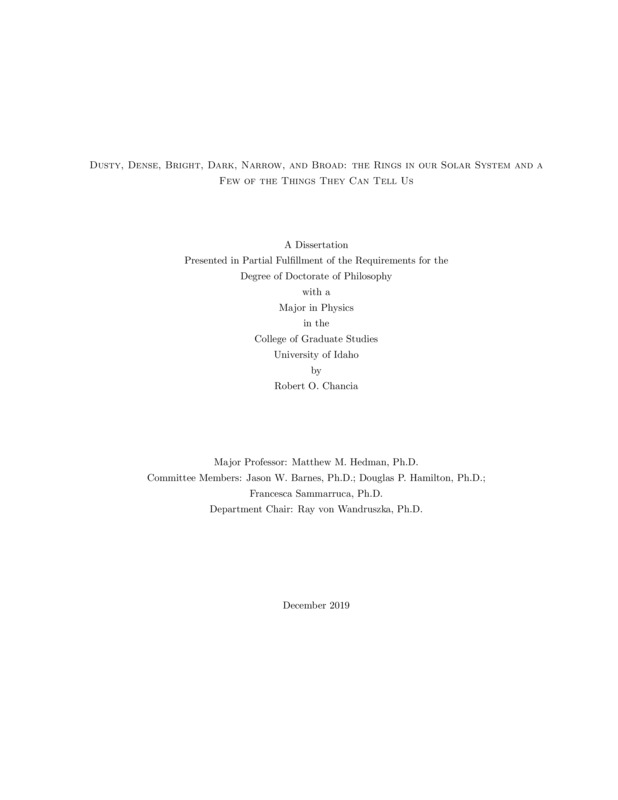Dusty, Dense, Bright, Dark, Narrow, and Broad: the Rings in our Solar System and a Few of the Things They Can Tell Us
Chancia, Robert Ormal. (2019-12). Dusty, Dense, Bright, Dark, Narrow, and Broad: the Rings in our Solar System and a Few of the Things They Can Tell Us. Theses and Dissertations Collection, University of Idaho Library Digital Collections. https://www.lib.uidaho.edu/digital/etd/items/chancia_idaho_0089e_11682.html
- Title:
- Dusty, Dense, Bright, Dark, Narrow, and Broad: the Rings in our Solar System and a Few of the Things They Can Tell Us
- Author:
- Chancia, Robert Ormal
- ORCID:
- 0000-0002-7867-7674
- Date:
- 2019-12
- Keywords:
- Magnetosphere Moons Planetary Rings Ring Dynamics Saturn Uranus
- Program:
- Physics
- Subject Category:
- Planetology; Astronomy; Astrophysics
- Abstract:
-
The observations of planetary rings acquired by the \textit{Cassini} and \textit{Voyager} missions and from the Earth have launched large advancements in our knowledge of planetary ring formation, evolution, and dynamics. Today, the study of the ring systems around our giant planets has evolved further into using the rings themselves as a tool to learn about their home planetary systems. In Chapter \ref{moonlets} we use two of the narrow rings of Uranus to probe for unseen nearby small moons who gravitationally interact with the rings and produce wake-like structures. These small moons both provide a possible solution for the confinement of their neighboring narrow rings and may represent a subset of the upper end of the ring particle size distribution. In Chapter \ref{eta} we detect the effects of a resonant induced radial mode in the Uranian $\eta$ ring. The amplitude of the radial oscillations observed in the $\eta$ ring allow us to estimate the mass of the perturbing moon Cressida. This is the first such measurement of small inner Uranian moon's mass and density. In Chapter \ref{roche} we track the presence and strength of periodic brightness variations in Saturn's dusty Roche Division and find that they are most likely caused by the seasonally varying planetary period oscillations of Saturn's magnetic field. This is just one of many ways in which the rings of Saturn have been found to be interacting with their magnetospheric environment.
- Description:
- doctoral, Ph.D., Physics -- University of Idaho - College of Graduate Studies, 2019-12
- Major Professor:
- Hedman, Matthew M
- Committee:
- Barnes, Jason W; Hamilton, Douglas P; Sammarruca, Francesca
- Defense Date:
- 2019-12
- Identifier:
- Chancia_idaho_0089E_11682
- Type:
- Text
- Format Original:
- Format:
- application/pdf
- Rights:
- In Copyright - Educational Use Permitted. For more information, please contact University of Idaho Library Special Collections and Archives Department at libspec@uidaho.edu.
- Standardized Rights:
- http://rightsstatements.org/vocab/InC-EDU/1.0/

